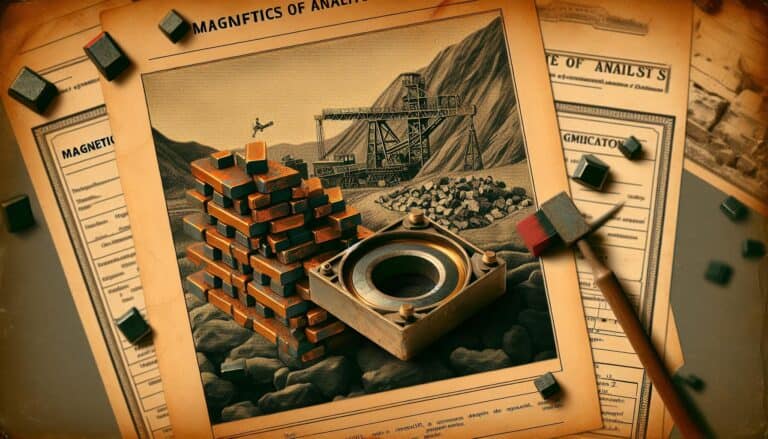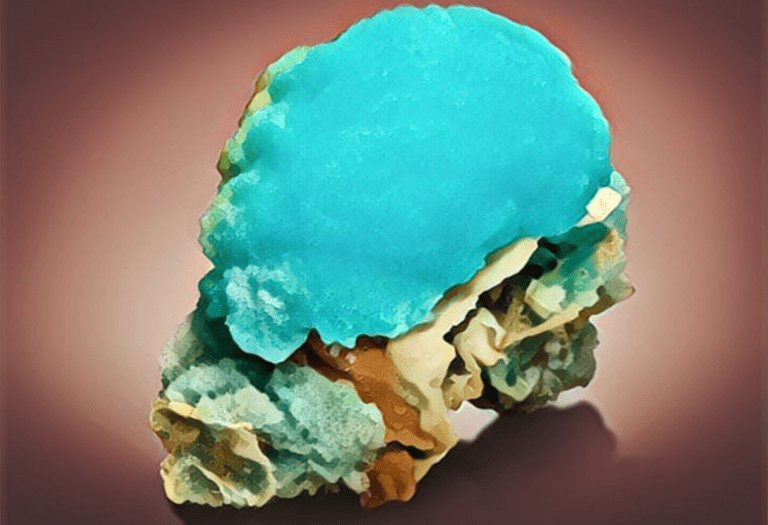Ever wondered where to uncover hidden geological treasures in Mississippi?
You’re in luck! The Magnolia State is a haven for rockhounds seeking to add to their collections. From the red clay hills to the river basins, Mississippi’s diverse landscapes offer a variety of minerals and fossils.
You’ll find spots teeming with petrified wood, agates, and even prehistoric shark teeth. Whether you’re a seasoned rockhound or just starting out, Mississippi’s rich soil is your playground.
Get ready to explore the best rockhounding locations and discover the unique finds that await you.
In Mississippi, rockhounding enthusiasts can explore diverse sites like Tishomingo State Park for limestone and chert, and Graves Mountain for quartz crystals. The Mississippi Petrified Forest offers petrified wood and agates, while the Gulf Coast near Biloxi yields shark teeth and fossils. Ensure compliance with local regulations during your exploration.
Get our FREE United States Rockhounding Map HERE

Mississippi Rockhounding Locations
As you delve into the world of rockhounding in Mississippi, you’ll find there are specific regions renowned for their geological wonders. Tishomingo State Park, located in the northeastern part of the state, is a rockhound’s paradise. It’s well-known for its large deposits of fossiliferous limestone and colorful mineral specimens like chert and ironstone. Hikers can enjoy the scenic trails while searching for geological finds.
Further south, Graves Mountain is another must-visit destination for avid collectors. Known for its variety of quartz crystals, including clear, smoky, and amethyst, it’s a spot that’s not only picturesque but also potentially rewarding. Remember to bring your tools and containers, as the chances of discovering something special here are high.
The delta region of Mississippi is incredibly rich in petrified wood. In particular, the Mississippi Petrified Forest in Flora showcases an ancient forest that has turned to stone over time. Enthusiasts can explore the trails and marvel at the beauty of these natural artifacts. Moreover, petrified wood isn’t the only treasure you can find there; keep an eye out for agates and quartz.
When heading towards the Gulf Coast, the coastal regions near Biloxi and Pass Christian offer up prehistoric shark teeth and Pleistocene epoch fossils. The beaches may prove to be the perfect spot for those looking for a more relaxing rockhounding experience. Just walking along the sandy shores could reveal hidden geological gems that the waves have washed up.
Central Mississippi also holds a trove of minerals. The rare zeolite minerals, such as stilbite and heulandite, can be found in certain areas, particularly around abandoned quarries.
Remember to check local regulations and obtain any necessary permissions before rockhounding. This not only ensures your safety but also preserves these locations for future generations of rock collectors.
| Location | Notable Finds |
|---|---|
| Tishomingo State Park | Fossiliferous Limestone, Chert |
| Graves Mountain | Quartz Crystals |
| Mississippi Petrified Forest | Petrified Wood, Agates |
| Coastal Biloxi | Shark Teeth, Fossils |
| Central Mississippi | Zeolite Minerals |
What Gemstones are Found in Mississippi?

Mississippi, often referred to as the “Magnolia State,” harbors a surprising variety of gemstones that pique the interest of rockhounds. As you explore this geologically rich state, you’ll find that it’s not just the history and culture that are colorful, but also the natural treasures beneath your feet.
Agate is among the most sought-after gems you can find here. These banded stones are prized for their intricate patterns and can be discovered in an array of locations including gravel pits and riverbeds. The vibrant bands of agate make each piece unique, with colors that can range from deep reds to soft blues.
Moving on, petrified wood offers a fascinating window into the ancient past. With its preservation of the original wood structure turned to stone, Mississippi’s Petrified Forest provides plenty of opportunities to find specimens of this gem. The variety and quality of petrified wood found here are unmatched, with polished sections revealing beautiful, woody textures that have been fossilized over millions of years.
If you are interested in sparkle, then quartz crystals can be your best bet. Varieties such as clear quartz, smoky quartz, and rose quartz are scattered throughout the state. Graves Mountain and areas around it are especially renowned for their quartz crystals, which can be unearthed in sizes ranging from small points to large clusters that dazzle with their crystal clear beauty.
In addition to these, opal, though less common, is another magnificent gemstone you might stumble upon in Mississippi. Spotting an opal’s distinctive play-of-color among the earth’s palette is always a thrilling moment for gem enthusiasts. While areas yielding opal are not as plentiful, if you’re dedicated and patient, your search could be richly rewarded.
Remember, always seek permission if you’re venturing onto private land for your rockhounding journey. With the right tools and a keen eye, you’ll be able to add some of Mississippi’s most precious gems to your collection.
What Sedimentary Rocks You Can Find in Mississippi?

When you’re trekking through Mississippi with your rockhound gear in tow, you’ll want to keep an eye out for the state’s abundant sedimentary rocks. These are typically formed by the deposition and subsequent cementation of mineral and organic particles on the floors of oceans, lakes, and rivers over millions of years.
Limestone is one of the most prevalent sedimentary rocks you’ll encounter in Mississippi. It’s often brimming with fossilized remains of ancient marine life, making each piece a natural time capsule. Limestone’s historical significance is monumental, given its use in the construction of many of Mississippi’s historical structures.
Then there’s sandstone, a rock that’s as gritty to the touch as it is visually fascinating. Exploring the yellows, reds, and browns of the sandstone found throughout the state is a geologist’s delight. Each hue tells a story of the minerals and conditions that formed it.
Shale, found in layers, reflects the fine silt and clay that settled in quiet waters long ago. It’s less resistant to erosion than other rocks, so you’ll often find it in softer, flatter areas. Shale can be an indicator of larger geological deposits and, thus, can guide your rockhounding journey.
Beyond the common rock types, unique sedimentary formations like chert might capture your attention. Chert is a hard, silica-rich rock that often appears as nodules or lenses within other sedimentary rocks. Don’t overlook this gem, as it’s perfect for more than just beginning collectors.
As you scour the landscapes of Mississippi, your discoveries are more than mere stones; they embody the state’s ancient environmental history. Your finds range from fossils to functioning crystals encased within sedimentary beds.
Remember to take note of the surroundings where these rocks are found. It can inform you about past sedimentary environments and perhaps lead to more exciting discoveries just a few feet away. Always keep your guidebooks handy to cross-reference rock types and formations, maximizing what Mississippi has to offer to the adventurous rockhound.
What Metamorphic Rocks are found in Mississippi?
Mississippi, with its rich geological tapestry, is also a haven for those interested in metamorphic rocks, although these are not as common as sedimentary types. Metamorphic rocks have been transformed by great heat and pressure, altering their original structure and mineral composition. In Mississippi, you can find these intriguing geological treasures if you know where to look.
One such rock is slate, which primarily originates from shale. Slate is often sought after for its fine grain and durability, making it a favorite among collectors. When scouting for slate, look towards the areas where older sedimentary rocks are present, as this indicates the necessary conditions for slate formation.
Marble, formed from limestone under conditions of high temperature and pressure, is another metamorphic rock found in Mississippi. It’s cherished for its beautiful crystalline appearance and variety of colors. Marble deposits are sporadic within the state, but they can be found in areas with a history of intense geological activity.
Quartzite is a lesser-known player in the metamorphic rock category in Mississippi. Born from quartz-rich sandstone, quartzite is a hard rock that resists weathering and can range in color from white to appealing shades of pink and red. You’ll likely find quartzite in Mississippi’s hilly terrains where erosion has exposed ancient rock formations.
For the intrepid rockhound, venturing into the state’s diverse landscapes will yield not just a wealth of sedimentary rocks as mentioned earlier, but also these metamorphic varieties. To enhance your chances of success:
- Bring a geological map to identity areas with ancient rocks.
- Contact local rockhounding clubs for insights.
Remember, always respect private property and obtain permission before entering any rockhounding sites. With the right preparation and a keen eye, you might just unearth a metamorphic gem.
What Igneous Rocks can You Find in Mississippi?
Rockhounding in Mississippi isn’t complete without the thrill of unearthing igneous rocks, the crystalline treasures formed from cooled magma. As you scour Mississippi’s landscape, granite and gravel deposits containing igneous components are among the treasures that await.
Granite, renowned for its coarse-grained texture and durability, often surfaces in the northern parts of the state. It’s composed predominantly of quartz, feldspar, and mica, presenting a spectrum of colors from salt-and-pepper grays to pinks. Here’s a crucial tip: the Tombigbee National Forest is a known spot where rockhounds seek granite boulders and pebbles. Their unmistakable speckled patterns make them easy to identify amongst riverbeds and old quarries.
Additionally, Mississippi’s riverbeds and gravel pits are filled with rocks that originate from igneous processes. While not directly cooled from liquid magma within the state, these pebbles have traveled from igneous-rich regions, carried here by ancient glacial movement and river flows. Rockhounds can sift through these gravel deposits to find unique specimens, including basalt and rhyolite fragments. These finds may be less common than sedimentary stones but provide an exciting challenge for enthusiasts.
Before you embark on your igneous rockhunt, gear up with sturdy gloves, a reliable rockhammer, and protective eyewear. Ensure to carry a magnifier to examine your finds closely—many of Mississippi’s igneous stones contain minute crystals and intricate patterns that are a delight to observe.
Keep in mind rockhounding etiquette and adhere to the American Federation of Mineralogical Societies’ Code of Ethics. Trespassing is a definite no-go, and always aim to leave no trace at your rockhounding locales. Whether meandering through the state’s thick forestry or digging through river sediment, you’ll soon discover that Mississippi’s igneous offerings add a fascinating layer to the rockhound’s experience.
Panning for Gold in Mississippi
While panning for gold might not be the first thing that springs to mind when you think of Mississippi, you’d be surprised at the prospecting opportunities that await you in the Magnolia State. The history of gold in Mississippi is not as prominent as in other states, but that doesn’t mean there aren’t hidden gems waiting to be discovered.
Mississippi’s gold deposits are primarily found in the form of flour gold, which are fine particles of gold that can only be collected with careful panning. Your best bet for finding gold is in Mississippi’s major rivers and their tributaries. Areas around the Mississippi River have been known to yield gold, with Marshall County being one notable region.
For the best experience, you’ll want to focus on streambeds where heavier materials have settled. Placer deposits, which are accumulations of valuable minerals formed by gravity separation during sedimentary processes, are your main area of interest when panning in Mississippi’s watercourses.
Before you start, ensure you have the right equipment. At a minimum, you’ll need:
- A sturdy pan designed for gold panning
- A snuffer bottle for sucking up the finer gold particles
- A classifier or screen to help separate larger rocks from finer material
Remember, patience is crucial when panning for gold. It’s a leisurely activity that requires attention to detail and perseverance. For newcomers, consider researching or joining a local rockhounding group to learn the best techniques and locations from experienced prospectors.
Be mindful of private property and land regulations when you set out. Always seek permission if you’re entering private land, and respect the environment by not digging into riverbanks and practicing Leave No Trace principles. Public lands in Mississippi often require a permit for prospecting, so check in with the Bureau of Land Management or local authorities before you gather your gear and head out.
Gold panning in Mississippi may not yield the large nuggets of your dreams, but it offers a serene way to connect with nature while indulging in the thrill of the hunt. It’s about the experience, the outdoors, and the occasional glint in the pan that keeps the excitement alive.
Rocks and Minerals Found in Mississippi
Mississippi’s geologic landscape serves as a treasure chest brimming with a diverse array of rocks and minerals. Agate, known for its striking bands and vibrant colors, can often be unearthed along streambeds and gravel pits. This semi-precious stone is a variety of chalcedony, and each piece you find could be unique in its pattern and hue.
In the rugged terrains, you may stumble upon quartz crystals, a testament to Mississippi’s rich mineral deposits. Quartz is one of the most common and varied minerals on Earth, and finding a crystal clear specimen is a rare joy for any rockhound’s collection. Petrified wood, a fossilized remnant of ancient forests, is also prevalent in certain areas, notably around the Mississippi Petrified Forest, boasting an array of colors and designs etched into stone.
For those interested in more opaque materials, the soapstone found in some regions of Mississippi is notable for its softness and ease of carving. Soapstone has been used for centuries by Native Americans and offers a direct link to the storied history of the land.
Presence of Fossils
Often hidden among the common stones, fossils reveal Mississippi’s ancient marine past. Look for fossilized shells, shark teeth, and even whale vertebrae in locations where waters once flowed. Finding a fossil can be an exhilarating experience as you hold a piece of natural history in your hands.
Gemstone Enthusiasts’ Delight
Rare finds such as garnets and epidote may reward the persistent hobbyist exploring stream beds or old mine tailings. These gems, though not as abundant as in some other states, can sometimes be found glinting in the Mississippi sun, offering a glimpse into the state’s hidden geological wealth.
Whether you’re sifting through river sediments for microscopic gold flakes or scouring the landscapes for hidden gemstones, Mississippi’s geological variety ensures there’s always something new to discover. Remember that part of the joy is in the journey, as each expedition brings its own set of challenges and surprises, just waiting for you to reveal them.
Where Can I Find Fossils in Mississippi?
Embarking on a journey to find fossils can lead you to some of Mississippi’s unique treasure troves. Mississippi’s rich, silt-laden areas along riverbanks and stream beds are prime spots for fossil enthusiasts. One of the more popular destinations is the banks of the Mississippi River where the ebb and flow of water uncovers fossils that have been buried for millennia.
The Mighty Mississippi River
When the river’s water level drops, especially during the summer droughts, you’ll find opportunities to scour the exposed riverbed. Here, fossilized shells and shark teeth are commonly found treasures. It’s important to pay attention to local regulations and ensure you have the necessary permits if required.
North Mississippi Gravel Beds
In the northern part of the state, gravel beds can yield impressive finds such as trilobites and crinoid stems. These areas are remnants of ancient sea beds, and with patience and a keen eye, your search can be highly rewarding. Be sure to bring the right tools: a geologist’s hammer, small shovel, and a sturdy brush can make a significant difference in your rockhounding experience.
- Red Bluff: Known as Mississippi’s “Little Grand Canyon,” this site offers an assortment of fossilized plant leaves and stems.
- The Petrified Forest in Flora: While mainly known for its petrified wood, this preserved area also provides a glimpse into various other prehistoric life forms.
Remember to respect the natural environment and never over-collect. By maintaining ethical rockhounding practices, you’re preserving these historical locales for future generations of fossil hunters. Your discoveries not only add to your collection but also contribute valuable information to the fascinating history of Mississippi’s ancient marine past.
Mississippi Rockhounding Laws & Regulations
Before you embark on your rockhounding adventure in Mississippi, it’s crucial to familiarize yourself with the state’s rockhounding laws and regulations. Understanding these rules not only protects you legally but also helps to preserve Mississippi’s natural heritage.
Respect Private Property
You’re probably eager to start sifting through gravel to find agate or scanning exposed cliff sides for quartz but remember that much of the land in Mississippi is privately owned. Always seek permission from landowners before entering private property. Trespassing is not only illegal but it reflects poorly on the rockhounding community.
Know the Public Land Rules
Public lands in Mississippi provide great opportunities for rockhounding. However, state laws prohibit the collection of artifacts, which includes any materials of cultural significance. When in national forests such as the De Soto National Forest, take note that you can collect small amounts of rocks and minerals for personal use, but commercial collecting is prohibited. It’s also important to:
- Avoid cultural or historic sites
- Leave no trace of your visit
- Abide by the U.S. Forest Service guidelines
Navigating Waterways and Beaches
Mississippi’s waterways and beaches can be hotspots for finding fossils and petrified wood. Navigating these areas requires extra care. Focus on areas below the ordinary high water mark as the state holds jurisdiction. Steer clear of altering or digging into the bank sides, as this can lead to erosion or other environmental impacts.
Environmental Considerations
Rockhounding in Mississippi isn’t just about what you find—it’s also about protecting the environment you’re exploring. Ensure you’re not disrupting wildlife habitats or collecting protected species. Use tools that minimize harm, such as small shovels or sifters, and avoid using heavy machinery that can significantly alter the landscape.
Rockhounding Tips for Beginners in Mississippi
Gearing Up: Essential Tools for Rockhounding
Embarking on your rockhounding adventure in Mississippi begins with the right tools. Start with a sturdy backpack to carry your finds and essentials comfortably. Crucial items include:
- Geologist’s hammer for chipping and prying
- Chisels and pry bars for extracting samples
- Gloves to protect your hands
- Safety glasses to safeguard your eyes from flying debris
Choose tools that are durable and suitable for the terrain you’ll be exploring. Lightweight equipment makes your journey easier, and a magnifying glass or hand lens allows you to inspect your finds closely on the go.
Safety Tips While Rockhounding
Your safety should be your top priority while rockhounding. Always let someone know your plans and stay aware of your surroundings. Dehydration poses a significant risk, especially in the Mississippi heat, so carry plenty of water. Wear appropriate clothing including:
- Sturdy footwear for rough terrain
- Long pants and sleeves to guard against scratches
- Hat and sunscreen to protect against sunburn
Watch for wildlife and be cautious on uneven ground. If you’re rockhounding near waterways, be mindful of the current and potential for sudden weather changes.
Legal Guidelines for Rockhounding Enthusiasts
As a rockhound in Mississippi, it’s crucial to familiarize yourself with legal guidelines that govern your hobby. Always get explicit permission from property owners before entering private land. On public lands, familiarize yourself with area-specific rules. For example, national forests may allow personal collecting but restrict commercial activity. Key points include:
- No digging into embankments or altering the landscape
- Keeping collection to surface finds where digging is not permitted
- Staying within the limits of personal use and not for resale
Remembering these guidelines helps preserve the natural beauty of Mississippi and ensures that rockhounding remains an enjoyable activity for years to come.
Conclusion: Mississippi Rockhounding Map
Armed with your geologist’s hammer, gloves, and a sense of adventure, you’re ready to explore Mississippi’s diverse geological landscape.
Remember to prioritize safety, respect landowner rights, and preserve the natural splendor you seek. Rockhounding isn’t just about the treasures you’ll find—it’s about the experience, the learning, and the memories you’ll create. So, gear up and set out on your journey to uncover Mississippi’s hidden gems. The state’s rich grounds await your discovery.
Happy rockhounding!


![Delaware Rockhounding Sites in [year]: Location & Hidden Gems](https://observationhobbies.com/wp-content/uploads/2024/01/OlSBM_jZS8pYfIDXCzqu-768x439.jpg)




